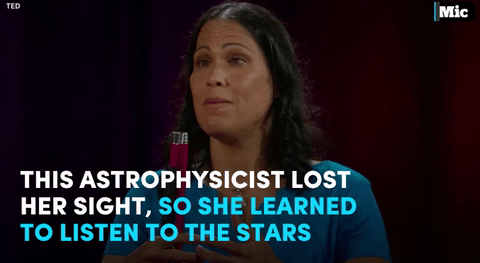299 posts
Latest Posts by curiositytherover - Page 2











follow @the-future-now










this is why we need vaccines (x) | follow @the-future-now





Watch: Bill Nye calls out CNN for employing a climate change denier right on CNN
Follow @the-future-now

Say ‘Hello’ to the Remote Controlled Gun-Wielding, Rocket Launching Vehicle


Jeff Williams: Record Breaker
Astronaut becomes U.S. record holder for most cumulative time in space!
The Olympics are over, but Americans are STILL breaking records. NASA astronaut Jeff Williams just broke Scott Kelly’s record of 520 cumulative days spent in space. When Williams returns to Earth on Sept. 5, he will have racked up 534 days in space. To celebrate this amazing achievement, here are some of the best images taken during his four spaceflights.

STS-101 Atlantis:
During May 2000, Williams made his first spacewalk during space shuttle Atlantis’ STS-101 mission. On this 10-day mission, Williams’ first spacewalk lasted nearly seven hours. He is pictured here outside the space station.

Expedition 13:
Williams experienced his first long-duration mission in 2006, when he served as flight engineer for Expedition 13 space station mission. During his time in orbit, he performed two spacewalks, saw the arrival of two space shuttle missions and resumed construction of the orbiting laboratory during his six-month tour. While on one of those spacewalks, Williams took this selfie.

Expedition 21/22:
Williams returned to space for another six-month mission in 2009 as a flight engineer on Expedition 21 and commander of Expedition 22. During that time, he hosted the crews of two space shuttle missions. The U.S.-built Tranquility module and cupola were installed on station. Here is an image of the then newly installed cupola.

Expedition 47/48:
This time around, Williams has been onboard the space station since March 2016, where he served as flight engineer for Expedition 47 and now commands Expedition 48. With over 7,000 retweets on Williams’ photo of an aurora from space, his Twitter followers were clearly impressed with his photography skills.
Make sure to follow us on Tumblr for your regular dose of space: http://nasa.tumblr.com

Sky-piercing towers, Hyperloop transports, driverless cars, and 3D-printed buildings. Welcome to Dubai, the City of the Future.

Humans might not be the only creatures that care about the welfare of other animals. Scientists are beginning to recognize a pattern in humpback whale behavior around the world, a seemingly intentional effort to rescue animals that are being hunted by killer whales.
Marine ecologist Robert Pitman observed a particularly dramatic example of this behavior back in 2009, while observing a pod of killer whales hunting a Weddell seal trapped on an ice floe off Antarctica. The orcas were able to successfully knock the seal off the ice, and just as they were closing in for the kill, a magnificent humpback whale suddenly rose up out of the water beneath the seal.
This was no mere accident. In order to better protect the seal, the whale placed it safely on its upturned belly to keep it out of the water. As the seal slipped down the whale’s side, the humpback appeared to use its flippers to carefully help the seal back aboard. Finally, when the coast was clear, the seal was able to safely swim off to another, more secure ice floe.
Read more
Read the study: Humpback whales interfering when mammal-eating killer whales attack other species: Mobbing behavior and interspecific altruism?
“The discovery of the odd arrangement — previously seen only in liquid helium, densely packed granules, and other non-biological systems — is more than a scientific curiosity, according to the statement. It could help lead to the development of optical circuits, light detectors, and other devices that transmit light with the efficiency of a crystal and the flexibility of a liquid.”


The Proxima Centauri Exoplanet: ESO Press Conference Set for Tomorrow

does anyone know of any good science blogs? I want to follow more.
Solar System: From TED Talks to Data Releases
Let us lead you on a journey of our solar system. Here are some things to know this week:
1. NASA-Funded Research

It’s all just a click way with the launch of a new public access site, which reflects our ongoing commitment to provide public access to science data.
Start Exploring!
2. Red Planet Reconnaissance

One of the top places in our solar system to look for signs of past or current life is Mars. Through our robotic missions, we have been on and around Mars for 40 years. These orbiters, landers and rovers are paving the way for human exploration.
Meet the Mars robots
3. Three Moons and a Planet that Could Have Alien Life

In a presentation at TED Talks Live, our director of planetary science, Jim Green, discusses the best places to look for alien life in our solar system.
Watch the talk
4. Setting Free a Dragon

Tune in to NASA TV on Friday, Aug. 26 at 5:45 a.m. EDT for coverage of the release of the SpaceX Dragon CRS-9 cargo ship from the International Space Station.
Watch live
5. Anniversary Ring(s)

Aug. 26 marks 35 years since Voyager probe flew by Saturn, delighting scientists with rich data and images. Today, thanks to our Cassini spacecraft, we know much more about the ringed planet.
Learn more about Cassini’s mission to Saturn
Learn more about Voyager 2
Discover the full list of 10 things to know about our solar system this week HERE.
Make sure to follow us on Tumblr for your regular dose of space: http://nasa.tumblr.com

Perseid Fireball at Sunset Crater

Perseids over Moosehorn Lake, Utah
Credit: Eric Benedetti
sorry guys I don’t really post on here anymore. I want to say an extremely late happy birthday to the Curiosity Rover and that I’ll try to post more in the future

Teaming with Bots!
NSF-funded Northwestern University roboticist Mike Rubenstein is helping NSF’s Science360 Radio pay homage to the National Robotics Initiative this week. We have his Big Picture Science interview about teeny tiny swarming robots called kilobots: 1.usa.gov/1r5QTz9

Self-assembly enables nature to build complex forms, from multicellular organisms to complex animal structures such as flocks of birds, through the interaction of vast numbers of limited and unreliable individuals. Creating this ability in engineered systems poses challenges in the design of both algorithms and physical systems that can operate at such scales. This work demonstrates programmable self-assembly of complex two-dimensional shapes with a thousand-robot swarm. Photo Credit: Michael Rubenstein, Harvard University




You can grab and fold this drone without hurting yourself


The geniuses at MIT have created a Wi-Fi network so high-tech it doesn’t need a password
Researchers at the Massachusetts Institute of Technology want to change how we connect to Wi-Fi. To avoid the cumbersome network login process, a team has come up with a way to grant computers access to a Wi-Fi network based on their proximity to a router. But what about security?
Follow @the-future-now

NASA is about to light the biggest human-made space fire ever
If a fire breaks out inside the cabin of a small spacecraft, there’s nowhere to run. But in order to figure out how large fires really behave in space, NASA is planning to light one on purpose. How they’re planning to conduct the test.
Follow @the-future-now

The internet is going to be 3-D printed in space, because why not
Majestic — a British provider of SEO services — is bringing both their internet graphing and futuristic printing capabilities to the final frontier, basically because they can.
Using a zero gravity-compatible 3-D printer onboard Orbital ATK’s recently launched Cygnus spacecraft, the #MajesticInSpace (MIS) project will produce a three-dimensional “data visualization of the entire internet,” according to SearchEngineLand. It’s expected to look something like the below model. Which is to say, not unlike a melting ice sculpture.
Follow @the-future-now

Is A Coincidence Ever JUST A Coincidence? The New Science Of Synchronicity
Mind Body Green writes:
Occasionally, two or three events in your life will intersect in a way that surprises you. One may be a thought or a feeling (internal) and the other happens in your environment (external). The two events have no apparent causal connection, but the surprise captures your attention and causes your mind to search for meaning. You wonder if it’s a coincidence or if it means something for you or for your life.
These moments appear in all parts of our finances, work, family, romance, health, ideas, and spirituality, as well as in movies, books, and the news. Like sex, they help make the world go round.
According to one Weird Coincidence Survey the most frequent coincidence is:
“I think of an idea and hear or see it on the radio, TV, or Internet.”
Just below that on the list are:
“I think of calling someone only to have that person unexpectedly call me.”
“I think of a question only to have it answered by external media (i.e., radio, TV, people) before I can ask it.”
“I advance in my work/career/education through being in the right place at the right time.”
Carl Jung introduced the idea of meaningful coincidences to the Western world with the term “synchronicity.”
The purpose of synchronicity, according to Jungians, is to further psychological growth and change—the process of individuation—of becoming who you truly are.
Keep Reading

XKCD has been tapped to teach high schoolers science
What if your most fearsome high school subjects like physics, chemistry and biology could be explained in humorous stick-figure drawings? That is exactly what textbook giant Houghton Mifflin Harcourt hopes to do by hiring 31-year-old artist and XKCD creator Randall Munroe to illustrate lessons. But wait, the collaboration gets even better for students.
Follow @the-future-now
How Do You Stay Fit on a Mission to Mars?
This mini exercise device could be the key!
Onboard the International Space Station, astronauts need to work out to maintain their bone density and muscle mass, usually exercising 2 hours every single day. Throughout the week, they exercise on three different pieces of equipment–a bike, a treadmill and the Advanced Restive Exercise Device (ARED).

All these devices are needed to keep an astronaut healthy.
However, deep-space vehicles like our Orion Spacecraft aren’t as roomy as station, so everything — including exercise equipment — needs to be downsized. The Miniature Exercise Device (MED-2) is getting us one step closer to being able to keep astronauts’ bodies healthy on long journeys to the moon, Mars and beyond.

MED-2 is a compact, all-in-one exercise device that we developed and will be launching to the space station Tuesday, March 22. Onboard the station, we’ll see how MED-2 will perform in microgravity and how it will need to be further adapted for our Journey to Mars. However, it’s already pretty well equipped for deep space missions.
So what makes MED-2 so great for deep space travel and our Journey to Mars?
1. It is an all-in-one exercise device, meaning it can do both aerobic and resistive workouts. When we go to Mars, the less equipment we need, the better.

2. It’s incredibly light. The MED-2 weighs only 65 pounds, and every pound counts during space missions.

3. It has 5 - 350 pounds of resistance, despite weighing only 65 pounds. Astronauts don’t all lift the same amount, making the flexibility in MED-2’s “weights” essential.

4. It’s tiny. (Hence its name Miniature Exercise Device.) Not only is MED-2 incredibly light, but it also won’t take up a lot of space on any craft.

5. It powers itself. During an aerobic workout, the device charges, and then that power is used to run the resistive exercises. When traveling to space, it’s good when nothing goes to waste, and now astronauts’ workouts will help power the Journey to Mars.

MED-2 is only one of many devices and experiments flying on Orbital ATK’s Cygnus spacecraft. To find out more about the science on the space station, follow @ISS_Research and @Space_Station on Twitter.
Make sure to follow us on Tumblr for your regular dose of space: http://nasa.tumblr.com

Prototype Robotic Lunar Lander, Testing at Marshall Space Flight Center
Source: http://www.nasa.gov/images/content/388176main_0901812_full.jpg
Cygnus Cargo Craft: What’s Onboard?

New experiments are scheduled to arrive to the International Space Station with the launch of Orbital ATK’s Cygnus cargo spacecraft on Tuesday. These science payloads will study fires, meteors, regolith, adhesion and 3-D printing in microgravity.
Take a look at the experiments:
Saffire-I

What is it? What happens when you set a fire in space? The Spacecraft Fire Experiment-I (Saffire-I) will find out!
How does it work? This experiment will intentionally light a large-scale fire inside an empty Cygnus resupply vehicle after it leaves the space station and before it re-enters Earth’s atmosphere.
Why is it important? The Saffire-I investigation provides a new way to study a realistic fire on an exploration vehicle, which has not been possible in the past because the risks for performing studies on manned spacecraft are too high. Instruments on the returning Cygnus will measure flame growth, oxygen use and more.
Meteor

What is it? A less heated investigation, Meteor Composition Determination (Meteor) will enable the first space-based observations of meteors entering Earth’s atmosphere from space. Meteors are somewhat rare and are difficult to monitor from the ground because of Earth’s atmosphere.
How does it work? This investigation uses high-resolution video and image analysis of the atmosphere to acquire the physical and chemical properties of the meteoroid dust, such as size, density and chemical composition.
Why is it important? Studying the elemental composition of meteors adds to our understanding of how the planets developed, and continuous measurement of meteor interactions with Earth’s atmosphere could spot previously unforeseen meteors.
Strata-1

What is it? A more “grounded” investigation will study the properties and behavior of regolith, the impact-shatterd “soil” found on asteroids, comets, the moon and other airless worlds.
How does it work? The Strata-1 experimental facility exposes a series of regolith simulants, including pulverized meteorite material, glass beads, and regolith simulants composed of terrestrial materials and stored in multiple transparent tubes, to prolonged microgravity on the space station. Scientists will monitor changes in regolith layers and layering, size sorting and particle migration via video images and close examination after return of the samples to Earth.
Why is it important? The Strata-1 investigation could give us new answers about how regolith behaves and moves in microgravity, how easy or difficult it is to anchor a spacecraft in regolith, how it interacts with spacecraft and spacesuit materials and other important properties.
Gecko Gripper

What is it? From grounded to gripping, another investigation launching takes inspiration from small lizards. Geckos have specialized hairs on their feed called setae that let them stick to vertical surfaces without falling, and their stickiness doesn’t wear off after repeated use. The Gecko Gripper investigation tests a gecko-adhesive gripping device that can stick on command in the harsh environment of space.
How does it work? The gripping device is a material with synthetic hairs much like setae that are much thinner than a human hair. When a force is applied to make the tiny hairs bend, the positively charged part of a molecule within a slight electrical field attracts the negatively charged part of its neighbor resulting in “stickiness.” Once adhered, the gripper can bear loads up to 20 pounds. The gripper can remain in place indefinitely and can also be easily removed and reused.
Why is it important? Gecko Grippers have many applications on current and future space missions, including acting as mounting devices for payloads, instruction manuals and many other small items within the space station. In addition, this technology enables a new type of robotic inspection system that could prove vital for spacecraft safety and repair.
Additive Manufacturing Facility

What is it? From adhesion to additive, the new Additive Manufacturing Facility (AMF) will also launch on the flight. Additive manufacturing (3D printing) is the process of building a part layer-by-layer, with an efficient use of the material.
How does it work? The AMF uses this technology to enable the production of components on the space station for both NASA and commercial objectives.
Why is it important? Parts, entire experiments and tools can be created on demand with this technology. The ability to manufacture on the orbiting laboratory enables on-demand repair and production capability, as well as essential research for manufacturing on long-term missions.
These sticky, stony and sizzling investigations are just a sampling of the wide range of science conducted on the orbiting laboratory that benefits future spaceflight and provides Earth-based benefits as well.
Watch the Launch!
You can watch the launch of Orbital ATK’s Cygnus spacecraft online. Stream live coverage starting at 10 p.m. EDT on March 22. Launch is scheduled for 11:05 p.m., which is the start of a 30-minute launch window.
Watch online: nasa.gov/nasatv
Make sure to follow us on Tumblr for your regular dose of space: http://nasa.tumblr.com
